TRIM11, a direct target of miR-24-3p, promotes cell proliferation and inhibits apoptosis in colon cancer
- PMID: 27888625
- PMCID: PMC5349951
- DOI: 10.18632/oncotarget.13550
TRIM11, a direct target of miR-24-3p, promotes cell proliferation and inhibits apoptosis in colon cancer
Abstract
TRIM11 (tripartite motif-containing protein 11) is an E3 ubiquitin ligase recently identified as an oncogene in malignant glioma and lung cancer. In the present study, we report that expression of TRIM11 was increased in colon cancer (CC) tissue relative to paired normal tissues and that higher TRIM11 levels predicted poor overall survival (OS) and disease-free survival (DFS) in CC patients. Mechanistically, we showed that miR-24-3p downregulation contributes to TRIM11 upregulation in CC. We also demonstrated that TRIM11 overexpression promotes cell proliferation and colony formation and inhibits apoptosis in CC, while knocking down TRIM11 using CRISPR/Cas9-mediated genome editing inhibited cell proliferation and induced apoptosis. Silencing TRIM11 in vivo decreased tumor growth. These findings indicate that TRIM11 facilitates CC progression by promoting cell proliferation and inhibiting apoptosis and that the novel miR-24-3p/TRIM11 axis may be a useful new target for treating patients with CC.
Keywords: TRIM11; colon cancer; miR-24-3p.
Conflict of interest statement
The authors have no potential competing interests as defined by Oncotarget, or other interests that might be perceived to influence the results and/or discussion reported in this article.
Figures
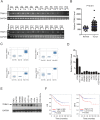
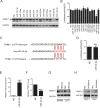

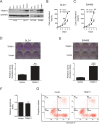
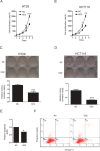
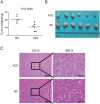
Similar articles
-
TRIM11 Posttranscriptionally Modulated by miR-5193 Facilitates Tumor Growth and Metastasis of Prostate Cancer.Technol Cancer Res Treat. 2023 Jan-Dec;22:15330338231178639. doi: 10.1177/15330338231178639. Technol Cancer Res Treat. 2023. PMID: 37248611 Free PMC article.
-
Expression of Tripartite Motif-Containing Proteactiin 11 (TRIM11) is Associated with the Progression of Human Prostate Cancer and is Downregulated by MicroRNA-5193.Med Sci Monit. 2019 Jan 4;25:98-106. doi: 10.12659/MSM.911818. Med Sci Monit. 2019. PMID: 30608062 Free PMC article.
-
Tripartite Motif Containing 11 Interacts with DUSP6 to Promote the Growth of Human Osteosarcoma Cells through Regulating ERK1/2 Pathway.Biomed Res Int. 2019 Dec 25;2019:9612125. doi: 10.1155/2019/9612125. eCollection 2019. Biomed Res Int. 2019. PMID: 31950060 Free PMC article.
-
LncRNA LUADT1 is Upregulated in Mantle Cell Lymphoma and Modulates TRIM11 by Sponging miR-24-3p to Inhibit Cell Apoptosis.Crit Rev Eukaryot Gene Expr. 2021;31(5):33-40. doi: 10.1615/CritRevEukaryotGeneExpr.2021038929. Crit Rev Eukaryot Gene Expr. 2021. PMID: 34591388
-
TRIM11 promotes lymphomas by activating the β-catenin signaling and Axin1 ubiquitination degradation.Exp Cell Res. 2020 Feb 15;387(2):111750. doi: 10.1016/j.yexcr.2019.111750. Epub 2019 Nov 28. Exp Cell Res. 2020. PMID: 31786079 Review.
Cited by
-
MicroRNA miR-24-3p Reduces Apoptosis and Regulates Keap1-Nrf2 Pathway in Mouse Cardiomyocytes Responding to Ischemia/Reperfusion Injury.Oxid Med Cell Longev. 2018 Dec 2;2018:7042105. doi: 10.1155/2018/7042105. eCollection 2018. Oxid Med Cell Longev. 2018. PMID: 30622671 Free PMC article.
-
lncRNA CCAT1 promotes bladder cancer cell proliferation, migration and invasion.Int Braz J Urol. 2019 May-Jun;45(3):549-559. doi: 10.1590/S1677-5538.IBJU.2018.0450. Int Braz J Urol. 2019. PMID: 31038865 Free PMC article.
-
Expression profiling of microRNAs in human bone tissue from postmenopausal women.Hum Cell. 2018 Jan;31(1):33-41. doi: 10.1007/s13577-017-0181-y. Epub 2017 Sep 20. Hum Cell. 2018. PMID: 28933035
-
CRISPR/Cas9-mediated gene knockout in human adipose stem/progenitor cells.Adipocyte. 2020 Dec;9(1):626-635. doi: 10.1080/21623945.2020.1834230. Adipocyte. 2020. PMID: 33070670 Free PMC article.
-
Snail promotes metastasis of nasopharyngeal carcinoma partly by down-regulating TEL2.Cancer Commun (Lond). 2018 Sep 25;38(1):58. doi: 10.1186/s40880-018-0328-6. Cancer Commun (Lond). 2018. PMID: 30253797 Free PMC article.
References
-
- Wang CY, Guo ST, Wang JY, Yan XG, Farrelly M, Zhang YY, Liu F, Yari H, La T, Lei FX, Jin L, Zhang XD, Jiang CC. Reactivation of ERK and Akt confers resistance of mutant BRAF colon cancer cells to the HSP90 inhibitor AUY922. Oncotarget. 2016;7:49597–49610. doi: 10.18632/oncotarget.10414. - DOI - PMC - PubMed
-
- Ordonez-Moran P, Dafflon C, Imajo M, Nishida E, Huelsken J. HOXA5 Counteracts Stem Cell Traits by Inhibiting Wnt Signaling in Colorectal Cancer. Cancer Cell. 2015;28:815–829. - PubMed
MeSH terms
Substances
LinkOut - more resources
Full Text Sources
Other Literature Sources

